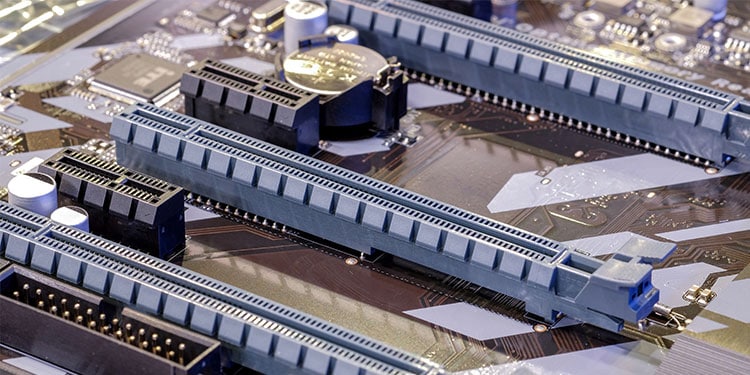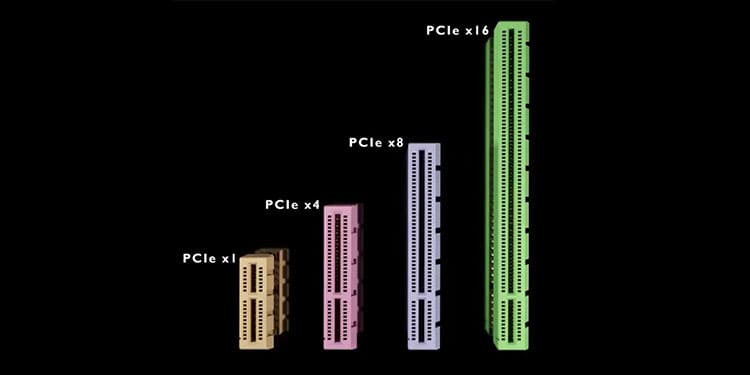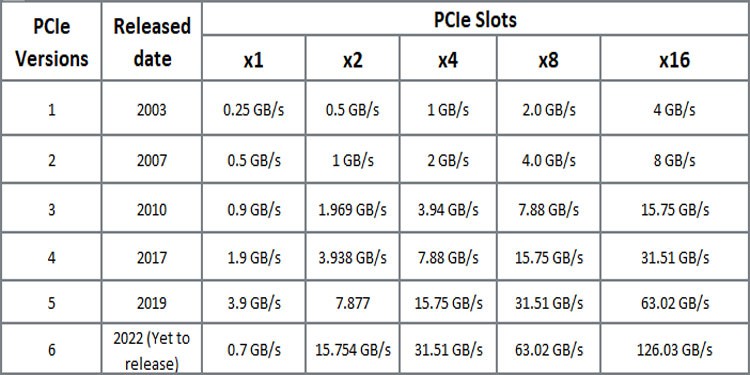Today we are here to discuss the difference between PCIe 3.0 and PCIe 2.0. Before we start, let us see what a PCIe is.
What is PCIe?
PCIe, or the Peripheral Component Interconnect Express, acts as an interface that connects various internal PC components such as the graphics card, SSD (Solid State Drive), sound card, NIC (Network Interface Card) card, etc. to the motherboard. You may wonder why we use PCIe to connect vital computer components. Well, one specific reason is that the PCIe offers high-speed data transfer that components, such as the GPU, require constantly.
PCIe versions
As of date, we have five versions of PCIe, PCIe 1.0 to 5.0. However, the PCIe version is not to be confused with PCIe lanes, which we will discuss later in the article. Basically, with each generation of PCIe, you will have greater bandwidth, transfer rate, and frequency. For less tech-savvy readers, this means that the internal components connected to their respective PCIe slots will perform a lot better. Furthermore, when you have a graphics card connected to a higher version of PCIe, your games will also run at higher Frames Per Second (FPS), giving you a smooth experience.
PCIe Lanes
Some may think that PCIe lanes and PCIe slots are the same. However, this is not quite the case. PCIe lanes act as the medium through which PCIe slots transfer data to the motherboard. There can be four, eight, sixteen, or thirty-two lanes of PCIe on a motherboard. PCIe x4 means this slot uses four lanes to transfer its data. Other PCIe slots use the remaining lanes. However, x16 can use either 8 or 16 PCIe lanes.
PCIe Slots
Depending on the motherboard, you will have multiple PCIe slots. PCIe x1 is the shortest slot with one PCIe lane, whereas PCIe x16 and x8 is the longest slot. PCIe x8 uses eight lanes, whereas x16 can use either eight or sixteen lanes. For example, consider that your motherboard has 20 total PCIe lanes in total. If x16 uses 16 PCIe lanes, you now only have 4 PCIe lanes left on your motherboard.
PCIe 3.0 Vs PCIe 2.0 – Differences
Now that we know about the PCIe, its lanes, and slots, let us discuss compare PCIe 3.0 and PCIe 2.0 in terms of encoding, bandwidth, transfer speed, and frequency. Furthermore, depending on the slot sizes and version, these terms vary as well. So without further delay, let us see what PCIe 3.0 brought to the table. First, let’s look at some key differences between PCIe version 3.0 and 2.0.
Encoding
The physical layer of PCIe 3.0 uses 128B/130B encoding, whereas PCIe 2.0 uses 8B/10B encoding. This means than PCIe 2.0 is not very efficient, since, among the 10 bits of data transmitted from the source, 8bits (i.e. 20% of total transmission) are overhead. In contrast to PCIe 3.0, which uses 128b/130b encoding, meaning that only 1.5% of total transmission is overhead. Clearly, PCIe 3.0 looks efficient in terms of encoding than PCIe 2.0. PCIe version 3.0, 4.0, and 5.0, all uses 128b/130b encoding. However, PCIe 6.0 uses 242/256b encoding, which means that 0.9% of total transmission is overhead.
Bandwidth
Below, we have compared the PCIe version according to the bandwidth that each version supports. As we can see, PCIe 3.0 offers twice the bandwidth compared to PCIe 3.0. This goes for other versions too, meaning that new versions of PCIe will provide double the amount of bandwidth compared to the previous versions.
Transfer Rate
The maximum data transfer rate for PCIe 3.0 is 8 GT/s (Giga Transfers Per Seconds), whereas version 2.0 is 5GT/s. Below, we have compared all versions according to the transfer rate.
Power Usage
Since PCIe 3.0 uses an efficient encoding, it transfers more data per second. In contrast to PCIe 2.0, which uses the same power to transfer data at a lower speed. This means that PCIe 3.0 is also more power-efficient compared to the previous generation’s extension slot.
FPS Performance
In the case of the graphics card, communication between the card and the motherboard needs to be a lot faster. Since PCIe 3.0 offers more bandwidth and frequency than its previous generation 2.0, it also provides some extra frames in few games. Unfortunately, in some games, you can expect the same FPS. This is because a game’s FPS mostly depends on PCIe lanes rather than bandwidth.
What Are the Similarities Between PCIe 2.0 Vs PCIe 3.0
Here’re some of the similarities between PCIe 2.0 and PCIe 3.0:
Physical Size
PCIe 3.0 and 2.0 are physically the same given that it is the same slot, i.e., x1, x4, or, x8. Meaning that x4 PCIe 3.0 and x4 PCIe 2.0 are exactly similar. So, if you want to use the latest version of the PCIe card on an older generation motherboard that has a lower version of PCIe slot, you can absolutely do that.
Compatibility
Since the physical size of both PCIe 3.0 and PCIe 2.0 is the same, they are compatible with each other. Therefore, if your motherboard has a PCIe 3.0 and the graphics card has PCIe version 2.0, you can connect them. Unfortunately, this will cause a bottleneck and the data transfer rate between the PCIe slot and port is the lower of the two. For example, if you have connected PCIe 2.0 and PCIe 3.0, the motherboard will use the transfer speed of PCIe 2.0.


